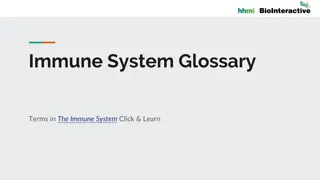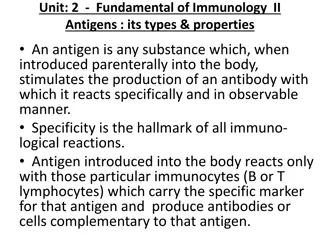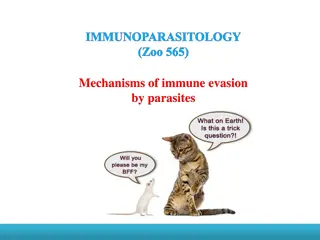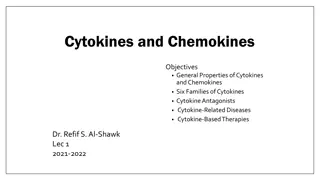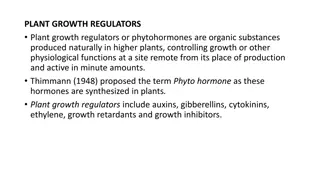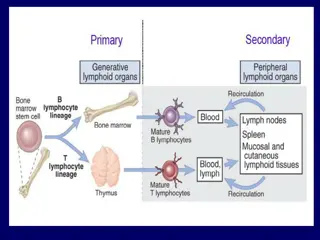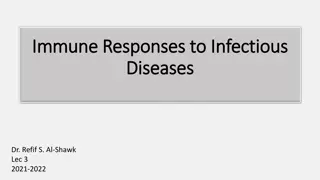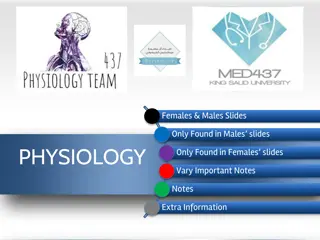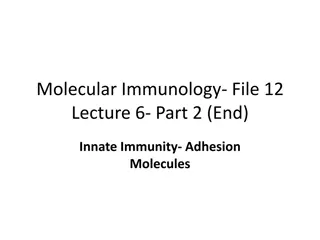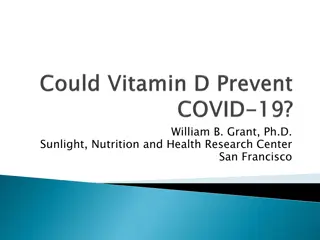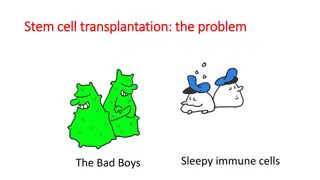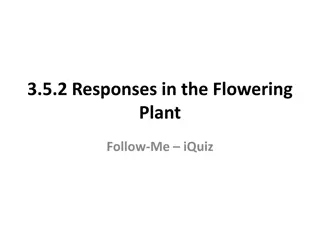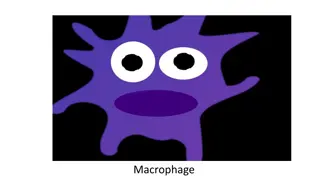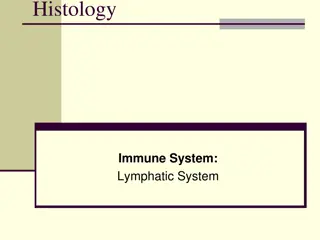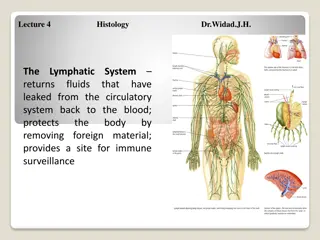Cytokines: Key Regulators of Immune Communication and Response
Cytokines play a crucial role in immune response by facilitating cell communication and coordination. They guide immune cells to infection sites, enhance pathogen-fighting abilities, and regulate inflammation. Learn about their functions, classifications, and association with various diseases. Understand how cytokines act at different distances and exhibit receptor specificity, high affinity, and signal transduction. Explore key features such as pleiotropy and antagonism. Test your knowledge with a quiz on cytokine actions.
Download Presentation

Please find below an Image/Link to download the presentation.
The content on the website is provided AS IS for your information and personal use only. It may not be sold, licensed, or shared on other websites without obtaining consent from the author.If you encounter any issues during the download, it is possible that the publisher has removed the file from their server.
You are allowed to download the files provided on this website for personal or commercial use, subject to the condition that they are used lawfully. All files are the property of their respective owners.
The content on the website is provided AS IS for your information and personal use only. It may not be sold, licensed, or shared on other websites without obtaining consent from the author.
E N D
Presentation Transcript
Cytokines: Key Regulators of Immune Communication and Response Dr Refif S. Al-Shawk 2024-2025
Learning objectives After reading this lecture, you should be able to: Define cytokines and chemokines 1. Describe the general properties of cytokines and chemokines 2. Understand Cytokine Functions: Describe the roles and classification of cytokines in immunity. 3. Explain Key Cytokine Families: Summarize the functions of IL-1, Class 1, Interferon, TNF, IL-17, and Chemokine families. 4. Relate Cytokines to Diseases: Identify cytokine dysregulation in conditions like autoimmune diseases and infections. 5.
Cytokines: Key Communicators of the Immune System What Are Cytokines? Cytokines are proteins that help immune cells communicate and coordinate their responses. Think of cytokines as the "text messages" sent between cells to alert and direct them. Functions of Cytokines: 1.Guide immune cells to the site of infection or injury. 2.Activate immune cells, increasing their ability to fight pathogens. 3.Regulate inflammation, ensuring the immune response is balanced. Chemokines: Specialized cytokines that guide immune cells to specific sites. Example: CXCL8 (IL-8) attracts neutrophils to infection sites. Cytokines = "messengers" or "text messages" sent between immune cells. Chemokines = "GPS signals" guiding immune cells to infection sites.
Cytokines are Described by Their Functions and the Distances at Which They Act Cytokines are classified by the distance between the cell secreting the signal and the cell receiving it: Endocrine Action: Cytokines travel through the bloodstream to distant cells. Example: IL-6 in systemic inflammation. Paracrine Action: Cytokines act on nearby cells. Example: IL-8 attracts neutrophils to infection sites. Autocrine Action: Cytokines act on the same cell that secretes them. Example: IL-2 promoting T-cell activation.
General Properties of Cytokines and Chemokines Key Features: 1.Receptor Specificity: 1. Cytokines bind to specific membrane receptors on target cells. 2.High Affinity: 1. Cytokine-receptor interactions are highly specific and effective at low concentrations. 3.Signal Transduction: 1. Binding to a receptor triggers a cascade of events, leading to gene activation and biological effects.
Quiz Example Which cytokine action involves signaling nearby cells? a) Autocrine b) Paracrine c) Endocrine
Cytokine Properties: Key Features of Their Actions 1. Pleiotropy Definition: A single cytokine can have different effects on different target cells. 4. Antagonism Example: IL-4 promotes B-cell activation but also inhibits macrophage activation. Definition: One cytokine inhibits the effect of another. Key Concept: Cytokines adapt their effects based on the cell type and its environment. Example: IFN- inhibits IL-4 to block B-cell switching to IgE. 2. Redundancy Key Concept: Antagonism helps balance immune responses to prevent overactivation. Definition: Different cytokines can have similar functions. Example: IL-2, IL-4, and IL-5 all promote B-cell proliferation. 5. Cascade Induction Key Concept: Redundancy ensures that the immune system can function even if one cytokine is absent. Definition: One cytokine induces the production of additional cytokines. 3. Synergy Example: IL-1 stimulates IL-6 production. Definition: Two or more cytokines work together to enhance their effects. Key Concept: Cascade induction amplifies and extends the immune response. Example: IL-4 and IL-5 together promote IgE production more effectively than either alone. Key Concept: Cytokine teamwork amplifies immune responses.
Cytokines belong to 6 families Interleukin 1 (IL-1) Hematopoietin family (Class I) Interferon family (Class II) Chemokine family Tumor necrosis family Interleukin 17 (IL-17) Based on structural studies All have molecular mass less than 30kDa All have similarities and few rarely act alone
Family 1: IL-1 Cytokines Key Mediators of Inflammation Overview: IL-1 cytokines include IL-1 and IL-1 , primarily produced by activated macrophages, monocytes, and dendritic cells. Functions: Promote inflammation by inducing the release of additional cytokines and chemokines. Stimulate the liver to produce acute-phase proteins (e.g., C-reactive protein). Induce fever by acting on the hypothalamus. Clinical Relevance: Overproduction of IL-1 is linked to autoimmune diseases such as rheumatoid arthritis. [IL-1 promotes the production of inflammatory mediators like IL-6, TNF- , and prostaglandins, creating a vicious cycle of inflammation. This leads to persistent joint inflammation, a hallmark of rheumatoid arthritis]. IL-1 inhibitors are used as treatments in inflammatory diseases. Key Points: IL-1 : Primarily acts locally at the site of inflammation [as an alarmin to signal nearby immune cells]. IL-1 : Acts systemically, contributing to fever and acute inflammation [Induces acute-phase responses, such as the production of C-reactive protein (CRP) and other inflammatory proteins by the liver].
Family 2: Class 1 Cytokines Regulators of Immunity Overview: Class 1 cytokines (hematopoietin family) are critical for immune system regulation. produced by a range of immune cells (e.g., T cells, macrophages, dendritic cells) and non- immune cells (e.g., fibroblasts, endothelial cells). Their diverse sources enable them to regulate both immune cell functions and tissue homeostasis. Functions include: Cell Proliferation: Stimulates T-cell and B-cell expansion (e.g., IL-2). Differentiation: Promotes helper T-cell specialization (e.g., IL-4 for Th2 differentiation). Antibody Production: Drives B-cell differentiation into plasma cells (e.g., IL-6). Hematopoiesis: Encourages growth of granulocytes and macrophages (e.g., GM-CSF, G- CSF).
Family 2: Class 1 Cytokines Regulators of Immunity Key Members: IL-2: Stimulates T-cell proliferation and survival. IL-4: Promotes Th2 differentiation and IgE production. IL-6: Drives plasma cell differentiation and acute- phase response. GM-CSF: Stimulates production of granulocytes and macrophages. Clinical Relevance: Overproduction: IL-6: Inflammatory diseases like rheumatoid arthritis and cytokine storms. Therapeutic Targets: IL-6 inhibitors (e.g., tocilizumab) for autoimmune diseases. IL-2 agonists for cancer immunotherapy.
Family 3: Interferon Cytokines Guardians of Immunity Overview: Key Functions: Type I Interferons (IFN- , IFN- ): Secreted by virus-infected cells. Bind to interferon receptors on neighboring cells to inhibit viral replication. Type II Interferon (IFN- ): Produced by activated T-cells and NK cells. Activates macrophages to kill intracellular pathogens. Promotes differentiation of Th1 cells. Type III Interferon (IFN- ): Targets epithelial cells in the respiratory and gastrointestinal tracts. Enhances antiviral defense while minimizing inflammation. Class 2 cytokines include interferons (IFNs) that are critical for: Antiviral immunity. Regulation of immune responses. Three types of interferons: Type I (e.g., IFN- , IFN- ): Early antiviral response. Type II (e.g., IFN- ): Activation of macrophages and T-cells. Type III (e.g., IFN- ): Protects epithelial cells from viral infections.
Family 3: Interferon Cytokines Clinical Relevance: Mechanism of Action: Type I IFNs: Used in the treatment of hepatitis B and C. Implicated in autoimmune diseases like lupus (IFN overproduction) [Elevated Type I IFN activity is a biomarker for lupus and correlates with disease severity.] Type I and III Interferons: Bind to specific interferon receptors activate JAK-STAT signaling induce antiviral proteins. Type II IFN: Critical for fighting intracellular pathogens like Mycobacterium tuberculosis. Type II Interferons: Activates macrophages and enhances antigen presentation via MHC expression. Type III IFN: Potential therapy for respiratory viral infections like COVID-19 [Trials have shown that IFN- therapy can reduce viral replication in SARS-CoV-2 and other respiratory viral infections].
Family 4: TNF Cytokines Regulators of Inflammation and Apoptosis Overview: Key Members: TNF- : Members of the TNF family regulate inflammation, immune responses, and cell death. Produced by macrophages, T-cells, and fibroblasts. Promotes inflammation, fever, and endothelial activation. Contributes to autoimmune diseases (e.g., rheumatoid arthritis). TNF- (Lymphotoxin): Produced by activated T-cells and B-cells. Plays a role in lymphoid organ development and inflammation. Fas Ligand (FasL): Induces apoptosis in target cells. Important in maintaining immune homeostasis and preventing autoimmunity. Exist as soluble or membrane- bound forms. Key roles in tissue homeostasis, immune cell activation, and apoptosis.
Family 4: TNF Cytokines Regulators of Inflammation and Apoptosis Clinical Relevance: Overproduction of TNF- : Mechanism of Action: Linked to autoimmune diseases like rheumatoid arthritis, Crohn s disease, and psoriasis. TNF- binds to TNFR1 and TNFR2, activating: NF- B pathway: Promotes inflammation and survival. Caspase pathway: Induces apoptosis. Therapeutic Targeting: Anti-TNF drugs reduce inflammation in autoimmune conditions. FasL-targeted therapies in cancer and immune disorders [FasL-targeted therapies enhance anti-tumor immunity]. FasL binds to Fas receptors Activates caspases Apoptosis.
Family 5: IL-17 Cytokines Drivers of Inflammation Overview: Key Members: IL-17A: The prototype cytokine, drives inflammation and neutrophil recruitment. IL-17 family cytokines are involved in: Inflammation. Host defense against extracellular pathogens. Autoimmune disease pathogenesis. IL-17F: Works synergistically with IL-17A to amplify inflammatory responses. IL-17C, IL-17D, IL-17E (IL-25), IL-17F: Involved in tissue-specific immunity and inflammation. Produced mainly by Th17 cells, a subset of CD4+ T cells.
Family 5: IL-17 Cytokines Drivers of Inflammation Functions: Clinical Relevance: IL-17 in Autoimmunity: Dysregulated IL-17 levels drive chronic inflammation in diseases like psoriasis. Promotes Inflammation: Stimulates production of pro- inflammatory cytokines (e.g., IL-6, TNF- ). Induces chemokines for neutrophil recruitment. Host Defense: Essential for defense against fungal (e.g., Candida) and bacterial infections (e.g., Staphylococcus). Therapeutic Targeting: Anti-IL-17 monoclonal antibodies are used in treating psoriasis. Autoimmune Diseases: Overexpression linked to conditions like psoriasis, and rheumatoid arthritis.
Family 6: Chemokines Navigators of Immune Cell Migration Overview: Key Functions: Chemokines are a family of small cytokines that guide immune cells to infection or injury sites through chemotaxis. Cell Recruitment: Guide leukocytes to sites of infection or inflammation. Enhance immune surveillance. Classified based on the arrangement of cysteine residues in their structure: CC chemokines: Attract monocytes and macrophages. CXC chemokines: Attract neutrophils. CX3C chemokines: Mediate adhesion and migration. XC chemokines: Rare, mainly target lymphocytes. Lymphoid Organ Development: Direct the migration of dendritic cells (DCs) and T-cells during immune response. Role in Inflammation: Increase adhesion of leukocytes to the endothelium. Facilitate migration of cells through blood vessels to affected tissues.
Family 6: Chemokines Navigators of Immune Cell Migration Mechanism of Action: Chemokines bind to chemokine receptors (e.g., CCR, CXCR) on immune cells. Trigger intracellular signaling pathways. Drive immune cell migration up the chemokine gradient Clinical Relevance: Chronic Inflammation: Overexpression leads to diseases like rheumatoid arthritis and asthma. Therapeutic Targets: Blocking chemokine receptors limits disease progression.
Hypercytokinemia: The Cytokine Storm Definition: Cytokine interactions regulate immunity. Excess cytokine production can lead to inappropriate immune responses. What Happens? Overproduction of cytokines Immune hyperstimulation Cytokine Storm Can cause shock, multiorgan failure, or death. Pathogen Examples: Viruses: Influenza A, SARS-CoV-2. Bacteria: Streptococcus spp., Staphylococcus spp. Clinical Implication: Cytokine storms disrupt immunity, turning protective mechanisms into harmful ones.
Cytokines Have Numerous Biological Functions The total number of proteins with cytokine activity grows daily as research continues to uncover new ones . Table 12-1 summarizes the biological functions of some commonly encountered cytokines.
Quiz Question: 2- Which class 1 cytokine promotes B-cell differentiation into plasma cells? 1- Which cytokine in the TNF family is responsible for inducing apoptosis? a) TNF- b) FasL c) TNF- d) IL-1 a) IL-2 b) IL-4 c) IL-6 d) GM-CSF
References : Kuby Immunology 8th edition, 2019 Cellular and Molecular Immunology 10h edition, 2022 by Abul K. Abbas


